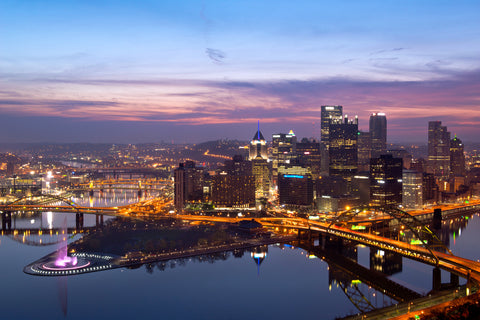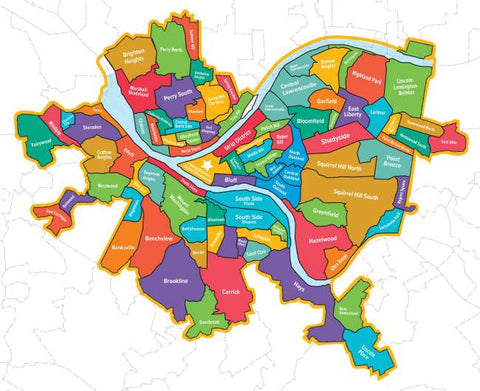Pittsburgh has a rich history, and that is an understatement! Although the city was established in the 1700s, the local Indigenous People had lived there for a very long time before colonialism. The Adena, Monongahela, Shawnee, Seneca, Lenape, and Iroquois Peoples, among others, have all lived on this territory for many years, according to historical data. Here's more detail on a few neighborhoods in Steel City!
Pittsburgh, which is split in two by the various hills, and a network of bridges, is situated where the Allegheny, Monongahela, and Ohio Rivers converge. Everyone, even the natives, finds it difficult to navigate this maze, but the inconvenience is worth it with the abundance of historical treasures, museums, eateries, and parks. Some of the city's neighborhoods are perched on the banks of rivers, while others cling to the slopes above, but they all nevertheless exude Pittsburgh's grittier pride. Exploring the city would simply require a car, a map, and a companion - so, let’s go exploring!
1. Yinzer’s Very Own Bayardstown
It is home to many of Pittsburgh's top eateries, a wide range of international grocery stores and retailers, small shops, and boutiques (many of which also feature international cuisine).
The mile-long "Strip District" stretches along the Allegheny River just northeast of Downtown. One of the most well-liked locations in the city for fantastic dining and entertainment is the Strip. Grab wall art from the local favorite yinzershop.

Here, former industrial and warehouse areas have been converted into a vibrant marketplace and the ideal architectural backdrop for the hippest bars, breweries, and eateries in the city. The freshest items are available in this region, doubling Pittsburgh's busiest market section during the day.
The Senator John Heinz History Center, situated near The Strip's entrance, provides a look at the people and occasions that have affected the area throughout its history, from difficult times to prosperous ones. There is nowhere better to get a sense of Pittsburgh's ongoing revitalization.
2. Oakland, the Home to Outstanding Attractions

Oakland, Pittsburgh's university and hospital district, is where students, healthcare professionals, and the fast-casual eateries and dive bars that supply them with food live. During the steel boom, when businessmen sought to show off their wealth, many of Pittsburgh's cultural institutions were left to the city and are located in this bustling area.
On Fifth Avenue, the Carnegie Library is next to the Carnegie Museum of Art and Natural History. You'll find dinosaur fossils, replicas of historic structures, and a stunning collection of contemporary art within, including Teenie Harris's photographic archive. Art has always been a part of yinzer’s interests. Add another one of our favorite pieces of the Oakland map to your collection!
3. Welcome to the South Side!

Image from Wikipedia
More restaurants and bars than any other area in the city are located on South Side. You will also notice wall art hanging at several pubs and restaurants as it is commonly used by locals here. Get one of your own to cherish South Side.
It is situated alongside the Monongahela River and stretches inland for many blocks after Station Square. The majority of pubs and restaurants in the South Side are situated along East Carson Street, which serves as the main thoroughfare. Workers for the steel mills that once lined the Monongahela River lived in the area historically.
Since the majority of these workers were from eastern Europe, the neighborhood has an ethnic atmosphere, with modest rowhomes, dozens of churches representing various ethnic groups, and even more local taverns and boutiques scattered throughout. Squat on each other, they balance precariously on the hillside.
4. Getting to Know Troy Hill

Image from Twitter
Surveyor and former Vice President of Pennsylvania, David Redick originally included Troy Hill in the Reserve Tract that he designed in 1788. German immigrants who worked in the mills, tanneries, breweries, and railroads that bordered the Allegheny River inhabited the area, which was incorporated in 1833 as the village of New Troy. The opening of a tiny cemetery by a Catholic church in 1842 sparked a movement up to Troy Hill.
100 families were residing in Troy Hill as of 1866. The upland including the settlement of Troy Hill was also annexed, becoming a part of the 7th ward, which later changed to the 13th ward of the city as a result of redistricting in 1877.
Saint Anthony's Chapel is the main draw. The stunning church, built in the manner of Europe, was dedicated in 1883 and now houses the largest collection outside of the Vatican. For tours, people go from close and far. La Hütte Royal is also located in Troy Hill. Outside, it appears to be a typical Pittsburgh house. However, within is a weird wonderland of art, sculpture, and odd artifacts that is immersive and macabre. You can also try and give a decorative edge to your home by getting an art piece of Troy hill.
Visit Penn Brewery for a fun environment and great brews. Penn Brewery, one of Pittsburgh's oldest and biggest craft breweries, offers German-style lagers and traditional Pittsburgh cuisine in a hip and historic setting.

Come Home To The Mighty Landscape Of Pittsburgh
The hills of Pittsburgh—the many, many hills—are one feature that never fails to startle visitors. The city's sports teams and former steel industry are well-known to foreigners. And indeed, those are significant urban areas. However, a large portion of Pittsburgh's communities and history is influenced by the topography.
Come visit the city for a lifetime's worth of memories! And, carry them back to your homes with intriguing art pieces from Yinzershop!




Comments (0)
There are no comments for this article. Be the first one to leave a message!